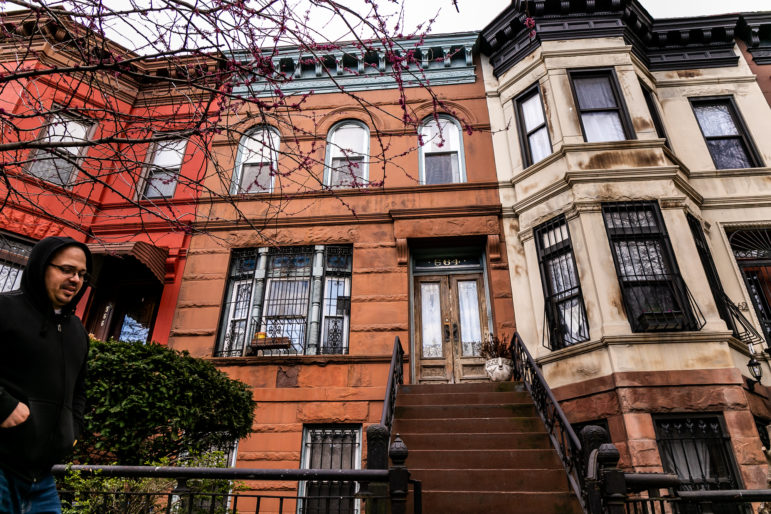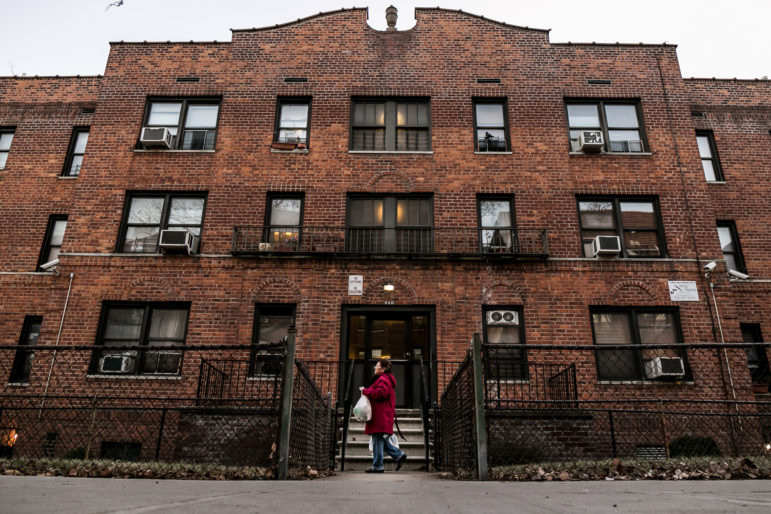
Adi Talwar
The brownstone center of frame was owned by the Gray family from 1924 to 2006. Prior to that, the Grays had owned property in nearby Weeksville from 1838 to 1928.
“If you look at the real history[,] whites took from minorities a lot,” Alan VanTine wrote in in response to a viral video about historic Weeksville. Viewed more than 9 million times in the first two months of 2018, the CurbedNY piece features the Hunterfly Road Houses at the Weeksville Heritage Center in present-day Central Brooklyn. A community of black landowners formed before the Civil War — in the 1830s — Weeksville merged with the growing city of Brooklyn by the turn of the nineteenth century. But it never disappeared (in contrast to the implicit message of the video). Descendants still live in the area. Preserved in 1968, the houses now anchor a thriving community arts organization — featuring exhibits, cultural programs, and historic house tours.
Why have I never heard of this historic settlement?? many commenters asked. What happened to it? In response to these questions, I offer the story of one black Weeksville family — the Gray family — who owned property in Central Brooklyn from before the Civil War, through the draft riots, the great migration, the waves of late 19th and early 20th century immigration, the New Deal and redlining, both World Wars, the bad days of the 60s and 70s, the new New York of the 1980s and 1990s, until they ran into the subprime mortgage crisis.
Why tell the story of the Gray family and not other Weeksville families? It’s just one of many threads I began investigating with my students in the NYU Museum Studies program in 2016. Of all the families we found in the census documents, this family happened to be traceable in the New York City property records — and I happened to finally meet a descendant in 2017.
In today’s New York City, we sometimes talk about neighborhood change as if it were a cohesive, organized event, but in fact, it’s made up of individual stories like this—complicated stories. We talk about renters and homeowners, their different fates amid the gentrification/displacement wave—but this story illustrates that homeowners, too, can be caught by the wave. We talk about the fact that neighborhoods are constantly changing, suggesting that life in NYC is ephemeral, but this story illustrates the fact that there are families—even families of color—with very deep roots, and that some of those roots, having survived so much, are only now being torn up.
Before I continue, I’ll just admit that I’m deliberately avoiding that current Gray-family descendant’s name because, after 167 years of property ownership in Central Brooklyn, she and her son lost the family home at the height of the subprime mortgage crisis. I don’t want to tell another victim-story. In fact, it was only because the Gray family had been so successful and had amassed such equity in their home, that subprime mortgage lenders targeted them.
But this wasn’t the first time the Gray family’s real-estate wealth faced a challenge. From sharecropping to contract selling, redlining to slum clearance to predatory lending, the plunder of black wealth, particularly real estate wealth, is one of the most consistent patterns in American history. The Gray family’s strategic commitment to inter-generational wealth transfer is evidence of something else: not victimhood but strategy, agility, and a focused determination to build black real-estate wealth and political power.
The family’s Weeksville story begins in 1838.
Mr. William Gray bought four lots at the intersection of Troy Avenue and the Long Island Railroad in 1838 — after the state of New York abolished slavery but before the Civil War. He built a two-story wood-frame home about four miles outside the city of Brooklyn. As a black man living in post-emancipation New York State, Mr. Gray needed to own property in order to vote. The state lifted property requirements for white men in 1821 but left them in place for black men.
Suggesting a deliberate effort to build political power by increasing black land ownership, an advertisement in Frederick Douglass’s North Star announced: “persons wishing to purchase and improve immediately will be accommodated on easy terms.” By 1840, thirty-two families lived in Weeksville and by 1850, nearly half of Brooklyn’s black property-owners lived in the settlement. According to historian Judith Wellman, the black population of Weeksville peaked in 1855 when 521 black residents were recorded in the New York State census. The superintendent of Long Island schools visited the settlement that year and found a “fine, tasteful” schoolhouse” in “a beautiful grove of oaks — surrounded by the small, neat white houses of thirty or forty colored families.”
The Gray family must have been meticulous about managing their real-estate wealth —particularly when it came to the legalities of property inheritance. As one observer wrote years later, much of the early landowners’ property “never passed into the possession of their heirs.”
Consider the case of Weeksville landowner Francis P. Graham, whose will suspiciously delivered all his real-estate holdings not to his wife or family members, but to his white lawyer in 1853. A judge rejected the obviously forged will, but after a couple more appeals, another judge awarded him all of the Graham family land, including more than 50 lots in Weeksville.
In contrast, the comparatively modest estate of the Gray family seems to have passed unceremoniously from William to his heirs, where in 1858, John Robert and Emily Gray began building a family together. James Weeks owned the lots adjacent to the Gray family but his descendants had a different experience. “Mr. Weeks owned a handsome dwelling at Schenectady and Atlantic avenues and a large plot of ground,” the New York Age reported in 1906. He died in 1864 but “his property never went into the possession of his heirs… It is said that the present occupants of the site have not a clear title.”
Possessed of real-estate valued at $2,000 in 1870, John-Robert and Emily Gray would eventually transfer the Troy-Avenue property to their son Harry B. Gray. Born in the middle of the Civil War in 1862, Harry was raised in a time of racial violence followed by triumph and optimism. His parents likely sheltered black refugees from Manhattan in the summer of Harry’s first year, when the terrifying New York draft riots sent hundreds across the East River to Brooklyn. It took another two years to secure freedom for enslaved African-Americans in the south. Four-year-old Harry and his parents were probably among the celebrants at Brooklyn’s Emancipation Jubilee in 1865. After the 1866 Civil Rights Act, young Harry Gray’s school was folded into the public school system, the word “colored” removed from its name.
Harry married Emma Nelson in 1888 and, like John-Robert’s bride before her, Emma Nelson moved into the family home on Troy Avenue with her in-laws. By then Harry was 25 years old and he’d been working as a letter carrier for four years, a coveted government position only recently made available to black men. Harry’s siblings seemed to move in and out of the family home as their life circumstances changed. In the late 1890s, his parents transferred the property into Harry’s name but continued to live in the home with their children and grandchildren.
The year Harry and Emma’s son Harry Jr. was born, the Gray family faced a substantial challenge to their family wealth. “Queer persons object to new school,” the Brooklyn Eagle reported. Below the headline: petitioners argued that a new “colored” school would drive down the value of local real estate. Lawyer and school-committee member T. McCants Stewart quickly corrected the record: it was only a new building, and it would not be “colored,” but racially integrated as it had always been. McCants spent three years convincing his colleagues and when it was all over, the racially integrated school anchored a racially integrated community for more than fifty years — until the 1950s. Had the petitioners succeeded in casting black proximity as a threat, the Gray family’s very presence would’ve devalued their own land.
Following an established pattern, Emma and Harry Gray left their Weeksville property to their daughter Octavia in 1924, who then bought a newer home — a brownstone in a wealthier neighborhood about ten blocks north of Weeksville, on Putnam Avenue. She paid $13,000 in cash.
Octavia’s decision to purchase the home outright was crucial to the preservation of her family’s wealth. In those days, purchasers usually paid sellers directly — writing the terms of their agreement directly into the deed. But the intimate nature of such arrangements left buyers vulnerable. Another Weeksville family bought a home on Macon Street and arranged a payment plan with the seller, but when the seller died, his property fell into the hands of an heir who repossessed the home. By the time she bought the new house Octavia had married Francis Giles, Jr., a lawyer and former banker. The two were uniquely positioned to navigate the potentially treacherous process of buying and holding real estate.
Octavia and her family had moved outside the boundaries of historic Weeksville, but it was a move enabled by their long history of property ownership in Weeksville. As far as I can tell, many of the Weeksville families followed a similar pattern in the early 1900s, moving to newer homes just outside the informal boundaries of the old settlement.
Octavia had watched the Weeksville area transition, not only from residential to commercial but from black to white, between the 1890s and the 1920s. Over the next thirty years, she would witness the same transition in reverse. The first transition happened after the Brooklyn Bridge opened in 1883, when European immigrants left the Lower East Side of Manhattan for the expanding tenement districts in Weeksville and Brownsville in Brooklyn. By the turn of the century, Weeksville’s streets were paved and most homes were owned by people with Italian surnames. When she moved ten blocks north in the 1920s, her new neighborhood was 95 percent white. But the area would be 95 percent black by the time she passed away 30 years later, in 1956.
Why did the Putnam Avenue neighborhood transition? First, because factories recruited black migrants to fill the job openings left by the 1924 immigration act (which had virtually halted the flow of laborers from southern and eastern Europe). Arriving from the coastal southern states or from the Caribbean islands, migrants tripled the black population of New York between 1920 and 1940. And secondly: redlining. In response to the Great Depression, the federal government involved itself in the real-estate market on an unprecedented scale. In the process, the Home Owners Loan Corporation (HOLC) hardened racist real estate practices — once practiced unevenly in local markets — into federal policy. In short, HOLC refused to insure banks that issued loans in areas where black people lived.
That meant banks quit loaning money in black neighborhoods. In turn, that meant property values dropped and white people left. White people were eligible to live elsewhere because their very presence didn’t signal a threat to property values. Furthermore, banks would readily lend them money to buy. How did this actually work? Section 2d of HOLC’s Area Survey asks for the “percentage of negro inhabitants.” In Bedford-Stuyvesant, the answer was more than zero, resulting in the lowest possible rating, a “D” and a red line around the neighborhood. No matter where a black person bought property, they brought the promise of property depreciation with them. And that’s how Octavia’s neighborhood changed.
Redlining prompted another transition too: in an area once dominated by owner-occupied single-family homes, rental units proliferated. Owners needed capital to maintain their enormous brownstones: to replace old windows or repair their roof, for example. Unable to secure loans from banks after redlining, many divided their properties into apartments and rented to other families. In some cases the owner remained in the home. Enterprising residents bought second properties and rented out an entire second building for income. That’s what happened to the building next door to Octavia’s.
The two transitions were related: from white to black and majority owner-occupied to majority rental, not because one caused the other, but because the invisible force of federal redlining practices caused both.
Octavia’s daughter grew up in the house on Putnam Avenue and raised her own daughter there. Born in 1944 and raised by several generations of her extended family, Octavia’s granddaughter stayed in the family home until 2006.
By the time the Putnam Avenue property passed into her name, her family had prevailed against a steady stream of challenges to their wealth. They escaped the fate of the Graham and Weeks families in the 1850s and 1860s. Then in the 1890s, when petitioners tried to devalue their property by insisting on an all-white school, the family emerged with their wealth in tact. In the 1920s, Octavia evaded a fourth possible trap, a contract sale on Putnam Avenue. But then, between the 1930s and the 1990s, everything changed. Instead of defending themselves against would-be thieves, the Gray family found themselves safely in possession of their home while redlining sucked the value right out of it, threatening the family’s wealth once again, this time not by theft but by quarantine. Still the Gray family thrived. Though it declined in exchange value, the Putnam Avenue home served as an incredible, stable resource for several generations.
Then a series of deregulatory measures changed the banking industry in the 1980s and 90s — and presented challenges the Gray family had not yet navigated. First, deregulation amplified both the presence and persistence of predatory lenders and speculators. Add to that the rising property values spilling over from Manhattan in the 1990s, and predators were incentivized to comb through publicly available real estate records in search of families like the Grays: people who’d amassed significant equity in their homes – then harass them with flyers, handwritten notes, and phone calls, even showing up unannounced to suggest they make specific repairs and then: suggest a loan to cover the cost of the repairs, thereby ensnaring owners in a dangerous contract, destabilizing their financial life, and rendering them amenable to selling the property they once owned outright.
What, exactly happened to prompt Octavia’s granddaughter to enter into such a contract? I don’t know. She doesn’t want to talk about it, understandably. I do know that she’d been forced out of work by health issues, so her income had dried up. Secondly, the area had been redlined since 1938 — before she was born — and residents had stopped asking banks for money long ago, knowing in advance that it was pointless. That alone put the Gray family in a vulnerable situation — having to rely on trust-networks to find a lender and then: having no other option, paying the high-interest rates those lenders demanded, but those factors alone were familiar and probably manageable.
In fact it was her son who signed the contract. It was 2002 and the time had come for Octavia’s granddaughter to follow the family tradition — by helping her own son buy a house. I can see a series of transactions in the NYC property records. Octavia’s granddaughter transferred ownership to her son in 2002. She owned the house in common with her mother, aunt, and cousin; they all signed quit-claim deeds, ceding ownership to William Gray’s 4th-great-grandson. By then, the Central-Brooklyn mortgage-desert had attracted the attention of Option One Mortgage Corp. Number six on the Center for Public Integrity’s “Subprime 25,” Option One originated at least $64.7 billion in high-interest loans between 2005 and 2007, at the height of their subprime lending practices. To finance the purchase of his own home in North Carolina, Octavia’s great-grandson took out a $130,000 mortgage from Option One in 2002, agreeing to an adjustable interest rate that began at 9.95 percent. By 2006, the interest rate had adjusted upward to 13.93 percent.
Lenders merely paved the way for speculators like Michael Feldman, who in 2006, bought the Gray family home for $450,000 and flipped it for $689,000 two months later. By then he’d been signing his name to real estate documents on behalf of Powerhouse Realty, LLC for nearly a decade, since 1998. He bought three Brooklyn properties that year and four more the following year, in 1999. The year he bought the Gray family home, he bought seven other Brooklyn properties, most of which he sold within a few months. He bought and sold more than 70 properties in Central Brooklyn between 1998 and 2011.
Unlike many Black families, the Gray descendants had wealth; they owned the home. But because the area was redlined, entities like Option One could effectively hold the family’s wealth hostage, demanding a form of ransom. Here was an instrument of thievery the family had not yet encountered. After more than a century-and-a-half of property ownership in Central Brooklyn, a perfect storm developed on Putnam Avenue: health problems, the slow and steady devaluation of property followed by rapid revaluation in the late 1990s and early 2000s, the long-term impact of redlining, and the deregulation of the banking industry that prompted far-away financial outfits to enter vacuums of capital and extract what profit they could.
Others have suffered worse. The Gray family sold and moved to North Carolina instead of losing everything to foreclosure. They earned money on the sale and used it to buy elsewhere.
The Weeksville Heritage Center is both a monument to the history of black land ownership in Central Brooklyn and a testament to this uncomfortable, complicated truth: Black wealth is under constant siege in this country. As the Gray family story illustrates, however, even under a system of unending plunder, some families thrived anyway. Until they didn’t.








6 thoughts on “The Gray Saga: A Two-Century Struggle to Preserve Black Wealth in Brooklyn”
Sad. However, if we could state a mistake, in hindsight that is, it would be that the Gray family didn’t stress this one important fact down to the last man, and that is, “Your enemy will always be out there. Sometimes he wears a suit, black robe, works in a bank or works to pass laws not in your favor.”
This article was very enlightening. The context provides some relevant information about community, home ownership, and social economic changes that impact our struggles and progress as people of color.
Great article. As a renter living in Bedford-Stuyvesant from the late 90’s through 2010 this article is really enlightening. It gives you a peek behind the curtain of what was enigmatic as I watched it happening around me. I ultimately saw a wonderful COMMUNITY dismantled by 2010.
Pingback: Black Lands Matter: The Movement to Transform Heirs’ Property Laws – TCNN: The Constitutional News Network
How may the Gray family get the home back?
If you find the answer or pathway, please reach out as I am a descendent of the Gray family. I just happen to stumble across this. Thank you and be well.